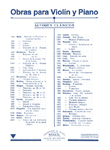La Fada (red.)
Drama líric en un acte
Voces, Coro mixto y Piano
MORERA, EnricReg.: B.2839
35,00 €
P.V.P. (VAT included 4%)
Add to cart
- Review: COHÍ I GRAU, Agustí
- Ensemble: Choir: With accompaniment; Mixt; With soloist(s).
- Genres: Classical / contemporary: Arrangements and Transcripts; Choir; Symphonic.
Incidental music: Operas / Operettas.
- Lyric author: MASSÓ I TORRENTS, Jaume
- Language: Catalán
- Product format: Partitura
- Difficulty level: Advanced-superior
- Period: 1st half S. XX
- Publishing house: Editorial Boileau
- Collection: Siglo XX
- No. of pages: 100
- Measure: 31,00 x 23,00 cm
- Lenght: 50'
- ISBN: 978-84-8020-021-9
- ISMN: 979-0-3503-3112-1
- Available in digital: No
- Available for rent: No
La Fada is a Wagnerian-influenced opera - endless melody, showy orchestration in keeping with the tastes of the time, emblematic value of the plot - based on one of the Croquis pirinencs that Jaume Massó i Torrents collected, together with other friends, during the fieldwork that, in a very romantic and daring manner, the first fortunate ethnomusicologists carried out at the end of the century. Two families at loggerheads in the medieval mists, two lovers -Jausbert de Paracolls and Gueralda de Évol- who know nothing of confrontation and who flee from the plains to the mountains in order to enjoy their passion; the intervention of a fictional character, the fada de l'estany (the fairy of the lake), typical of romantic literature, sometimes beneficent and in other cases - especially in Germanic traditions - perverse like Lorelei, decides the duel between Gueralda's father and Jausbert, so that, once the latter is dead, the fairy takes him to the bottom of the Estany Negre.
The opera lasts approximately 45 minutes. The tessitura of the voices is not high-pitched, as they are almost always in the middle register, and the language is largely atonal. The score is written for large orchestra, with the brass, especially the four horns, standing out.
The premiere was made possible by a close collaboration between the various institutions: if Massó served the libretto and Morera the music, Rusiñol gave the inaugural speech at the Festa Modernista, in which he praised the successes of one and the other; Miquel Utrillo painted the poster for the session, which, in addition to announcing the event and indicating its protagonists, highlighted the role of the fairy of the lake, a beautiful Pre-Raphaelite maiden who has nothing to do with the perversity of the real protagonist; Labarta designed the costumes, naively set in the same medieval world in which Wagner had set The Walkiria or many of his other productions. The railway company provided a special train to facilitate the transfer, and finally, the audience showed their willingness to be present at an event that was expected to be a huge crowd, as it was, filling the theatre hall to capacity. The sopranos Elisa de Petri and Amanda Campodonico, the tenor Morales, the Liceu choir and an orchestra prepared for the occasion made possible a result that will remain in the collective memory as a point of reference.
Escena I
Escena II
Escena III
Escena IV
Escena V
Escena VI
Escena VII
Escena VIII
Escena IX








